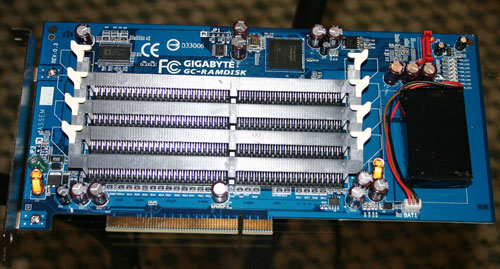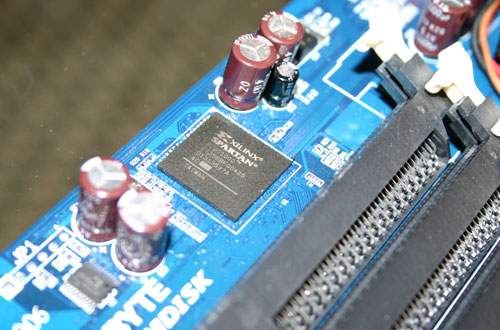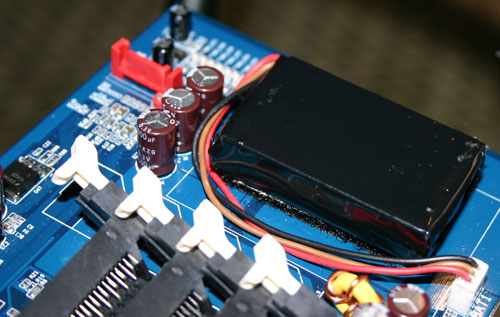Computex 2005 Early Bird Coverage: NVIDIA's G70, Athlon 64 BTX and more
by Anand Lal Shimpi on May 30, 2005 8:53 AM EST- Posted in
- Trade Shows
Gigabyte Brings Solid State Storage to the Mainstream
In an effort to differentiate themselves from other motherboard manufacturers, Gigabyte has introduced a number of interesting add-ons for their motherboards, the most interesting of which is their $50 RAMDISK PCI card.

The card is a regular 32-bit PCI card that features four standard DIMM slots on board. The card also features a custom Gigabyte FPGA that is programmed to act as a SATA to DDR translator, which convinces the SATA controller you connect the card to that the memory you have on that card is no different than a regular SATA HDD. As long as you have memory on the card, the card will be available at POST as an actual SATA drive, with no additional drivers necessary.

The Custom Gigabyte FPGA
The card is powered via the PCI slot, but RAM is volatile and thus if no power is provided to the card then all of the data is lost. In order to make this solution more realistic for real-world usage, Gigabyte outfitted the card with a rechargeable battery pack that can keep the memory powered and data intact for up to 16 hours with no power. After that 16 hours is up, your data is lost, but as soon as you apply power to the card again the battery pack will begin to recharge.

The Battery Pack and SATA connector. You connect a SATA cable from this port to the SATA controller on your motherboard and the RAMDISK will be treated as a hard drive.
Given that the card offers no real backup other than the battery it’s not really suitable for extremely sensitive data, but it works well if your system is on all the time. Obviously the biggest benefit of using DDR memory as storage is that all accesses occur in nanoseconds, not milliseconds and is thus much faster at random accesses than regular hard drives. Transfer rates are also improved, but you're limited by the bandwidth of the SATA interface so DDR200 memory is the fastest that is supported.
It is an interesting step for Gigabyte, and we’d like to see how the technology evolves over time.










80 Comments
View All Comments
michaelpatrick33 - Monday, May 30, 2005 - link
Or, you could put a whole Linux distribution on that and have some fun!Of course another drawback is that it is a 32bit PCI card, so you will only get a maximum of 133mBps sustained to the south/north bridge thus limiting it further. Still way faster than any hard-drive though.
AndreasM - Monday, May 30, 2005 - link
Ah yes, use a ramdisk for the swap file so the computer doesn't slow down when swapping data to it from ram. Or not.#17 has a point though, this would be useful for Intelists that have moved to DDR2 and still have their old DDR-sticks around. Though it would probably be a better idea to just sell those sticks and buy more DDR2 :P
stevty2889 - Monday, May 30, 2005 - link
#12 I think using that gigabyte ram drive for the swap file would be an excelent use for it, good idea!Icehawk - Monday, May 30, 2005 - link
I want that RAM-Disk. Here's why - I have a gig of older DDR ram that is essentially worthless. How about using the Ram-Disk for your virtual memory swap file? Ah... now you see the possible benefit?:)
Tanclearas - Monday, May 30, 2005 - link
I thought the idea behind BTX was to improve cooling through better air flow. Why would they place the IDE cables directly in-line with the CPU, and the power and SATA cables all nearly in-line with the CPU?!Matthew Daws - Monday, May 30, 2005 - link
What I don't quite get with the solid-state drive is: Why not just increase the amount of ram you have, and let the O/S use it as it sees fit, either for a huge disk cache, or for applications if they need it. This should actually be faster, as the OS can intelligently decide what data to buffer in ram; and with 64-bit nearly mainstream, you don't have a 4GB limit.The only issue might be that you'll have to spend a lot more on RAM you want to put on your motherboard than the dirt-cheap stuff you'd put on the Gigabyte board; but surely 2GB of extra system ram would be better than a 4GB Ram-Drive?
mjz - Monday, May 30, 2005 - link
yea, maybe if they have 8 slots and ram is 50 dollars a gig.mattsaccount - Monday, May 30, 2005 - link
The solid state drive would also be useful for photoshop/video editing scratch disks, or for the windows page file.MDme - Monday, May 30, 2005 - link
hey, you can put winXP onto that ramdisk and just have that. I mean if you use that as your OS partition, it will rock. maybe use a minimal XP install without the bloat-ware...maybe even a 512mb swapfile there. (I wonder how fast will boot times be???)OR
just use the ramdisk as the swap file. that would still be a boost. (you won't have to worry about the volatile ram either)
AnnihilatorX - Monday, May 30, 2005 - link
2GB should be enough for just Windowbut if you want "a" game on it... 4GB is just enough